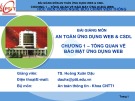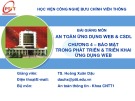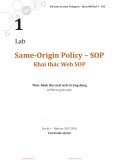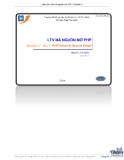
Web Security
CS-431

HTTP Authentication
•Protect web content from those who don’t have a “need to
know”
•Require users to authenticate using a userid/password before
they are allowed access to certain URLs
•HTTP/1.1 requires that when a user makes a request for a
protected resource the server responds with a authentication
request header
–WWW-Authenticate
•contains enough pertinent information to carry out a “challenge-
response” session between the user and the server
Web Server
Client
Client requests a protected resource
Server responds with a 401 (not
authorized and a challenge request
for the client to authenticate

Client Response
•Well established clients like Firefox, Internet Explorer …. will
respond to the challenge request (WWW-Authenticate) by
presenting the user with a small pop-up window with data entry
fields for
–userid
–password
–a Submit button and a Cancel button
•entering a valid userid and password will post the data to the server,
the server will attempt authentication and if authenticated will serve
the originally requested resource.

WWW-Authenticate
•The authentication request received by the browser will look
something like:
–WWW-Authenticate = Basic realm=“defaultRealm”
•Basic indicates the HTTP Basic authentication is requested
•realm indicates the context of the login
–realms hold all of the parts of security puzzle
»Users
»Groups
»ACLs (Access Control Lists)
•Basic Authentication
–userid and password are sent base 64 encoded (might as well be
plain text)
–hacker doesn’t even need to unencode all he has to do is “replay”
the blob of information he stole over and over ( this is called a
“replay attack”)

WWW-Authenticate
•Digest Authentication
–attempts to overcome the shortcomings of Basic Authentication
–WWW-Authenticate = Digest realm=“defaultRealm” nonce=“Server
SpecificString”
–see RFC 2069 for description of nonce, each nonce is different
–the nonce is used in the browser in a 1-way function (MD5, SHA-1….) to
encode the userid and password for the server, this function essentially
makes the password good for only one time
•Common browsers don’t use Digest Authentication but an applet could
as an applet has access to all of the Java Encryption classes needed to
create the creation of a Digest.




















![Câu hỏi ôn tập An toàn mạng [năm hiện tại]](https://cdn.tailieu.vn/images/document/thumbnail/2025/20250702/kimphuong555/135x160/56191751442800.jpg)

![Cẩm nang phòng chống, giảm thiểu rủi ro từ tấn công Ransomware [Mới nhất]](https://cdn.tailieu.vn/images/document/thumbnail/2025/20250627/vijiraiya/135x160/48331751010876.jpg)



